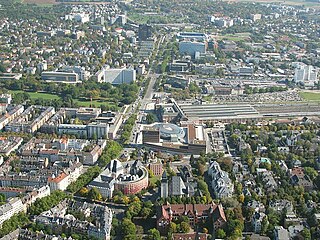
Wiesbaden is a city in central western Germany and the capital of the state of Hesse. As of June 2020, it had 290,955 inhabitants, plus approximately 19,000 United States citizens. The Wiesbaden urban area is home to approximately 560,000 people. Wiesbaden is the second-largest city in Hesse after Frankfurt am Main.

Friedrichshain-Kreuzberg is the second borough of Berlin, formed in 2001 by merging the former East Berlin borough of Friedrichshain and the former West Berlin borough of Kreuzberg. The historic Oberbaum Bridge, formerly a Berlin border crossing for pedestrians, links both districts across the river Spree as the new borough's landmark.

Wilmersdorf, an inner-city locality of Berlin, lies south-west of the central city. Formerly a borough by itself, Wilmersdorf became part of the new borough of Charlottenburg-Wilmersdorf in Berlin's 2001 administrative reform.

Biebrich is a borough of the city of Wiesbaden, Hesse, Germany. With over 38,000 inhabitants, it is the most-populated of Wiesbaden's boroughs. It is located south of the city center on the Rhine River, opposite the Mainz borough of Mombach. Biebrich was an independent city until it was incorporated into Wiesbaden in 1926.

Bierstadt is a borough of the city of Wiesbaden, capital of the state of Hesse, Germany. The district is located in the eastern part of the city, directly east of downtown Wiesbaden, and has about 12,300 inhabitants. Formerly an independent municipality, the town was incorporated into Wiesbaden on April 1, 1928. While Bierstadt can be translated Beer Town, the name is actually derived from Saint Brigid of Kildare, Ireland.

Erbenheim is a borough of Wiesbaden, capital of the federal state of Hesse, Germany. It was incorporated into Wiesbaden on April 10, 1928. The population is around 10,000.

Frauenstein is the westernmost borough of the city of Wiesbaden, located in the Rhine Main Area near Frankfurt and capital of the federal state of Hesse, Germany. The borough has a population of approximately 2,400. The formerly independent village was incorporated into Wiesbaden in 1928.

Sonnenberg is a borough of Wiesbaden, the capital of the state of Hesse, Germany. Formerly an independent municipality, Sonnenberg was incorporated into Wiesbaden on 28 October 1926. The borough has approximately 8,000 residents.

Schierstein is a southwestern borough of Wiesbaden, capital of state of Hesse, Germany. First mentioned in historical records in 860, Schierstein was incorporated into Wiesbaden in 1926. Today the borough has about 10,000 residents. Situated on the Rhine River, Schierstein is known as the "Gateway to the Rheingau."

Dotzheim is a western borough of Wiesbaden, capital of the state of Hesse, Germany. It is the second largest borough of the city by area and, with over 27,000 inhabitants the second-most populated of Wiesbaden's suburban boroughs. It was the largest village in the former Duchy of Nassau. The formerly independent village was incorporated into Wiesbaden in 1928.
Hessloch is a borough of Wiesbaden, the capital of the state of Hessen, Germany. It is the smallest and least-populated of Wiesbaden's boroughs with 663 residents. The formerly independent village was incorporated into Wiesbaden on 1 April 1928.

Igstadt is an eastern borough of Wiesbaden, capital of the state of Hesse, Germany. It was incorporated into Wiesbaden on April 1, 1928 and currently has about 2,200 residents.

Kloppenheim is a borough of Wiesbaden, capital of the federal state of Hesse, Germany. Kloppenheim was incorporated into Wiesbaden in 1928. The adjacent boroughs are Naurod, Auringen, Medenbach, Igstadt, Bierstadt, and Heßloch.

Bundesstraße 455 is a German Bundesstraße in the federal state of Hesse. The route runs southwest from Schotten in Vogelsbergkreis to Mainz-Kastel, a borough of the Hessian capital city of Wiesbaden.

Klarenthal is a borough of Wiesbaden, capital of the federal state of Hesse, Germany. The community, situated on the slopes of the Taunus Mountains, was planned by architect and urban planner Ernst May in the style of a commuter town in the early 1960s. It was built on free arable land between the railway line to Bad Schwalbach and Klarenthaler Straße, overlooking the city center of Wiesbaden proper. Klarenthal consists mainly of large multi-family homes and residential high-rise buildings, surrounded with much green space, as well as many townhouses. The ground-breaking ceremony was held on September 11, 1964 and the first residents moved in in late February 1966. Today, over 10,000 people live there.

Biebrich Palace is a Baroque residence (Schloss) in the borough of Biebrich in the city of Wiesbaden, Hesse, Germany. Built in 1702 by Prince Georg August Samuel of Nassau-Idstein, it served as the ducal residence for the independent Duchy of Nassau from 1816 until 1866.

Mitte is a borough of the city of Wiesbaden, Hesse, Germany. With over 21,000 inhabitants, it is one of the most-populated of Wiesbaden's boroughs. It is located in the centre of the city.

Westend is a borough of the city of Wiesbaden, Hesse, Germany. With a density of about 27,000 inhabitants per km² it is the most densely populated urban district in Germany. It is located in the centre of the city.

Nordost is a borough of the city of Wiesbaden, Hesse, Germany. With over 22,000 inhabitants, it is one of the most-populated of Wiesbaden's boroughs. It is located in the centre of the city. Nordost is known as the borough with the highest housing prices in Wiesbaden. Besides this Nordost has the highest purchasing power per inhabitant of all boroughs with about 29,000 Euro per inhabitant.

Südost is a borough of the city of Wiesbaden, Hesse, Germany. With over 21,000 inhabitants, it is one of the most-populated of Wiesbaden's boroughs. It is located in the centre of the city. Südost is known for plenty of state agencies settled there.






















